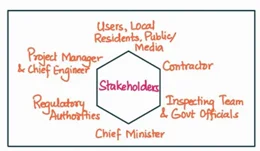Answer:
| Approach:
Introduction
Body
- Options available to the project manager
- Ethical dilemmas faced by the project manager
- Professional challenges likely to be faced by the project manager and their response to overcome such challenges
- Consequences of overlooking the observation raised by the inspecting team
Conclusion
|
Introduction:
In this case study, the project manager faces an ethical dilemma when a minor crack is noticed in one of the piers of an elevated corridor under construction. The chief engineer, driven by political pressure and personal interests, orders the manager to overlook the crack and continue working at the same speed. The project manager strongly believes that the crack will adversely affect the bridge’s health and safety.

Body:
(a) Options available to the project manager:
- Follow the chief engineer’s order and continue the work without addressing the crack, prioritizing the completion of the project within the deadline.
- Insist on proper repair and reconstruction of the piers, even if it leads to project delays, ensuring the safety and durability of the elevated corridor.
- Seek guidance from higher authorities or an external expert to make an informed decision on how to proceed.
- Communicate the issue to the Chief Minister directly, highlighting the potential risks and seeking approval for the necessary repairs.
- Consult with the inspecting team and other technical experts to explore alternative solutions that could address the crack while minimizing project delays.
(b) Ethical dilemmas faced by the project manager:
- Balancing the project manager’s professional responsibility for quality and safety against political pressures and personal career prospects.
- Maintaining transparency and integrity in decision-making, despite the influence of the minister and contractor who have personal interests in the project.
- Upholding the public interest and the well-being of future users of the elevated corridor, even if it means challenging the authority of superiors.
- Ensuring accountability and avoiding potential legal and moral consequences associated with compromising on safety standards.
- Balancing the short-term objective of completing the project before the elections with the long-term consequences of overlooking a potential risk.
(c) Professional challenges likely to be faced by the project manager and their response to overcome such challenges:
- Communicating the importance of safety and durability to the chief engineer and higher authorities, emphasizing the potential risks associated with not addressing the crack.
- Building a strong case by gathering technical evidence, conducting further inspections, and consulting with experts to support the need for reconstruction.
- Negotiating with the minister and contractor by presenting alternatives that prioritize safety without significantly compromising the project timeline.
- Seeking support from professional networks, industry associations, or regulatory bodies to advocate for adherence to quality standards.
- Documenting all discussions, decisions, and actions taken to maintain a record of the project manager’s commitment to professional integrity and due diligence.
(d) Consequences of overlooking the observation raised by the inspecting team:
- Increased risk of structural failure or accidents, potentially endangering the lives of future users of the elevated corridor.
- Reputation damage to the project manager, the college, and the government for compromising on safety standards.
- Potential legal repercussions and liabilities if any accidents or damages occur due to the neglected crack.
- Loss of public trust and confidence in the project and the authorities responsible for its construction.
- Long-term financial implications of retrofitting or repairing the piers after completion, which could be more costly and disruptive compared to addressing the issue during the construction phase.
Conclusion:
Project managers must choose between prioritizing safety and meeting political deadlines. Overlooking the observation raised by the inspection team could have severe consequences for safety, legal liabilities, professional reputation, and public trust.Making the right decision requires upholding integrity and responsible project management.
